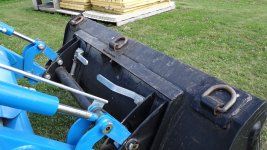HybridVigor
Bronze Member
What’s the difference between a farmer and a welder? A welder doesn’t pretend he can farm.
I welded hooks onto my L3301 a little over 5 years ago and they’re holding up fine. Basically my welding experience was an ag mechanics class and YouTube. It’s been a while but I think I used a root pass of 6011 and capped with 7018. I put a nice bevel on the arms, preheated first, and alternated sides after each full pass. I just had a Lincoln 220V AC only tombstone at the time.
Run some practice passes to get a feel for amps. I found the hardest part was holding the arms just so for the initial tack welds. You want the hooks to be parallel to the centerline of the tractor/front of the draft arm before the bend, which is easier said than done once you have your bevels.
I didn’t do this, but I sort of think you could bias the hooks vertically with the tops out away from the centerline of the tractor a few degrees since they naturally point towards the center of the tractor as you raise the three point. I welded them in-line with the draft arms and haven’t had any clearance issues, but they do rub every now and then with cat 2/1 balls which are only as wide as the hook. I used cat 2 limited hooks from Agristore USA
I welded hooks onto my L3301 a little over 5 years ago and they’re holding up fine. Basically my welding experience was an ag mechanics class and YouTube. It’s been a while but I think I used a root pass of 6011 and capped with 7018. I put a nice bevel on the arms, preheated first, and alternated sides after each full pass. I just had a Lincoln 220V AC only tombstone at the time.
Run some practice passes to get a feel for amps. I found the hardest part was holding the arms just so for the initial tack welds. You want the hooks to be parallel to the centerline of the tractor/front of the draft arm before the bend, which is easier said than done once you have your bevels.
I didn’t do this, but I sort of think you could bias the hooks vertically with the tops out away from the centerline of the tractor a few degrees since they naturally point towards the center of the tractor as you raise the three point. I welded them in-line with the draft arms and haven’t had any clearance issues, but they do rub every now and then with cat 2/1 balls which are only as wide as the hook. I used cat 2 limited hooks from Agristore USA
Last edited:

